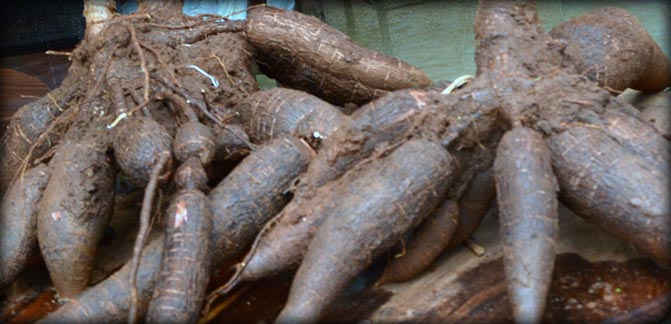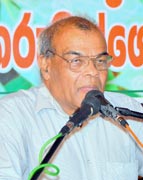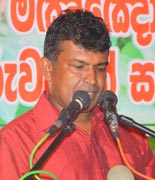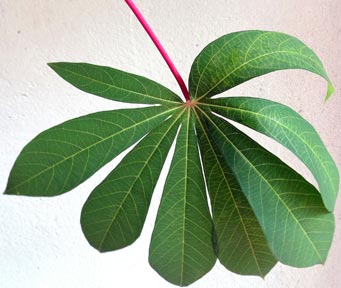 The
miracle of manioc The
miracle of manioc
Research find the humble tuber contains cancer curing
properties:
Reporting by A. Sumanasena, Kollonnawa Corr,
The humble manioc is turning out to be a miracle food that could hold
the ultimate secret to curing cancer. According to Dr. Channa Jayasumana,
lecturer, Rajarata University Medical Faculty, new research has in fact
proved that manioc, the yam and the leaves, both have cancer curing
properties. The research findings had also showed that manioc leaves
could have a cure for kidney diseases.
"Manioc is a nutritious food and those who consume manioc may never
have to face the many health hazards others fall prey to, Dr. Jayasumana
said. He was addressing a workshop organised by the Kirindiwela-Diyawela
Manioc Cultivators Association, under the theme 'Healthy Local Food
Consumption' at the Kirindiwela Village Conference Hall. Expressing hope
that maniac yam would be introduced to the market in various forms, Dr.
Jayasumana said manioc leaves, which are mostly consumed as 'mallum' in
Sri Lanka at present, will be supplied to the market as a tasty food
using modern technology.
He said, there was a lot of misconception about the humble, yet
invaluable, tuber in the minds of people, and claimed much of it had
arisen a misrepresented article written by him. Expressing his sorrow
about the misconception, he however said the present process of manioc
cultivation, where chemicals, in crystal and liquid form, are used to
destroy weeds, remove other unwanted plants and prepare the soil, were
not suitable for manioc cultivation.

Ayurvedic Doctor Y.P. Seneviratne.
|

President, Manioc Cultivators Association
A.L. Chanthana |

Rajarata University
Lecturer Channa
Jayasumana |
"It is similar to putting cow dung in the milk pot. I ask the local
farmers to cultivate manioc using natural methods without depending on
agrochemicals. Then the quality and the nutrients in the manioc yam can
be protected, Dr. Jayasumana said, adding that produced in an organic
manner, manioc could even sold in foreign markets.
Ayurvedic Dr. Y.P. Seneviratne, talking on the theme 'Ayurvedic
Medical Science' said Sinhala Ayurveda Medical System had also proved
that eating manioc could help cure certain non-communicable diseases
like cancer and kidney diseases.
"Western medical research has also proved this fact," he pointed out,
explaining that since the earlier days he has been instructing patients
who come to him for treatment of cancer and kidney related diseases, to
add manioc in their daily food. He said he also included manioc in his
menu at least two times a week and that those who follow his
instructions are in good health.
President of the Kirindiwela Manioc Cultivators Association, A.L.
Chandana, held a practical demonstration about manioc cultivation and
operating tractors and seed processing machines and methods of preparing
the soil.
Manioc cured my cancer - Dr. Cynthia Jayasuriya
 ENT
Surgeon, Dr. Cynthia Jayasuriya, addressing the gathering
via Skype, said she had been diagnosed with cancer and
eating manioc had helped cure her of the disease. "As a
western medical practitioner I have served in hospitals for
many years. When I was diagnosed with cancer, I underwent
treatment for a long time. But with the lapse of time the
disease became severe and there was hardly any improvement.
My doctor instructed that I undergo surgery. Being a doctor
I know the severity of such surgeries and the pain after the
surgery. So I did not agree to the surgery," Dr. Jayasuriya
said, explaining, "I searched in the internet for alternate
medicines which have been used for cancer in various
countries. I found that people in developed countries like
America, use apple seed and certain other grains for
cancer." ENT
Surgeon, Dr. Cynthia Jayasuriya, addressing the gathering
via Skype, said she had been diagnosed with cancer and
eating manioc had helped cure her of the disease. "As a
western medical practitioner I have served in hospitals for
many years. When I was diagnosed with cancer, I underwent
treatment for a long time. But with the lapse of time the
disease became severe and there was hardly any improvement.
My doctor instructed that I undergo surgery. Being a doctor
I know the severity of such surgeries and the pain after the
surgery. So I did not agree to the surgery," Dr. Jayasuriya
said, explaining, "I searched in the internet for alternate
medicines which have been used for cancer in various
countries. I found that people in developed countries like
America, use apple seed and certain other grains for
cancer."
Dr Jayasuriya said during her search she
had found out that manioc had the same nutrient value as the
seeds used in the western world for cancer. "I got my
children to bring home manioc and ate it boiled three times
a day. Overtime I saw my health condition gradually
improving. I felt an easiness in the body," she said.
Later she went to her oncologist, who
after carrying out the necessary checkups, asked what she
had done, as there were no detectable trace of cancer in her
body. "Without any hesitation I said I ate manioc three
times a day and that manioc was the reason the change," she
said, but pointed out that the doctors were not ready to
scientifically accept this. "But I am telling my cancer was
cured because I ate manioc." |
Cynthia's story
I developed secondary bladder cancer,
seven years after I was diagnosed with transitional cell
carcinoma of the ureter. My kidney, ureter and part of the
bladder were removed. I had radiation to the abdomen
thereafter. I was hale and hearty for seven years but on the
seventh year I experienced blood in the urine, as I had
developed a growth in the bladder. It was once again
transitional cell carcinoma.
The new growth was removed, but I was
worried about a recurrence. While I was convalescing I
learnt about Apricot seed kernel that was being used in
Australia and USA in place of chemotherapy. The apricot seed
kernel has a substance called Vitamin B17, which was
discovered by a British doctor who worked in a remote region
in Afghanistan as a missionary. He found the people of the
area measured their riches according to the number of
Apricot trees they owned. They ate not only the apricots but
also the apricot seed kernels.
The apricot seed kernel looks like an
almond in shape, size and smell. This is also known as the
'bitter almond'. The doctor discovered that people of the
region did not suffer from cancer. After investigating the
doctor found that the seed kernel contained a substance,
which has been given the name Vitamin B17.
As I was having cancer I was curious about
any food that had B17. By browsing the internet I found that
manioc also had a large concentration of Vitamin B17. So I
ate the manioc minimum of 10 grams three times a day. After
having consumed it for one month I underwent a cystoscopy
(examination of the bladder) at the General Hospital by the
same surgeon who treated me. He was surprised that my
bladder was absolutely clean and normal. "There was no place
to take any biopsy" were his very words to me.
While I was taking the manioc I was
feeling very fit and well and people around me noticed that
I looked well.
Armed with the examination results of the
bladder examination I published my story for the well-being
of all cancer patients in Sri Lanka.
Since then every three months I have gone
for examination of the bladder under the same surgeon and
every time my bladder has been clear. Up till now I have not
taken any treatment other than eating the manioc.
In a more simplistic way I would like to
explain how the Vitamin B17 in the manioc acts. The
scientific name of vitamin B17 is Amagadolin. We know that
cancer cells are immature cells and it has a different
enzyme to the normal cell enzyme.
When the Vitamin B17 combines with a
normal cell enzyme it breaks down into 3 sugars but when it
combines with the cancer cell enzyme it breaks into 1 sugar
1 benzaldehyde and 1 hydrocyanic acid.
The hydrocyanic acid kills the cancer cell
locally. What happens is that there is a substance called
B17 in the apricot seed kernel (and in manioc), which when
combined with a normal cell enzyme breaks down into three
sugars.
When B17 combines with a cancer cell (an
immature cell) it breaks down into one sugar, one
benzaldehyde and one hydrocyanic acid. The hydrocyanic acid
kills the cancer cell.
- Excerpts from 'My wonder drug for
cancer' by Dr. Cynthia Jayasuriya, published in the Sunday
Observer, July 24, 2011 |
|

